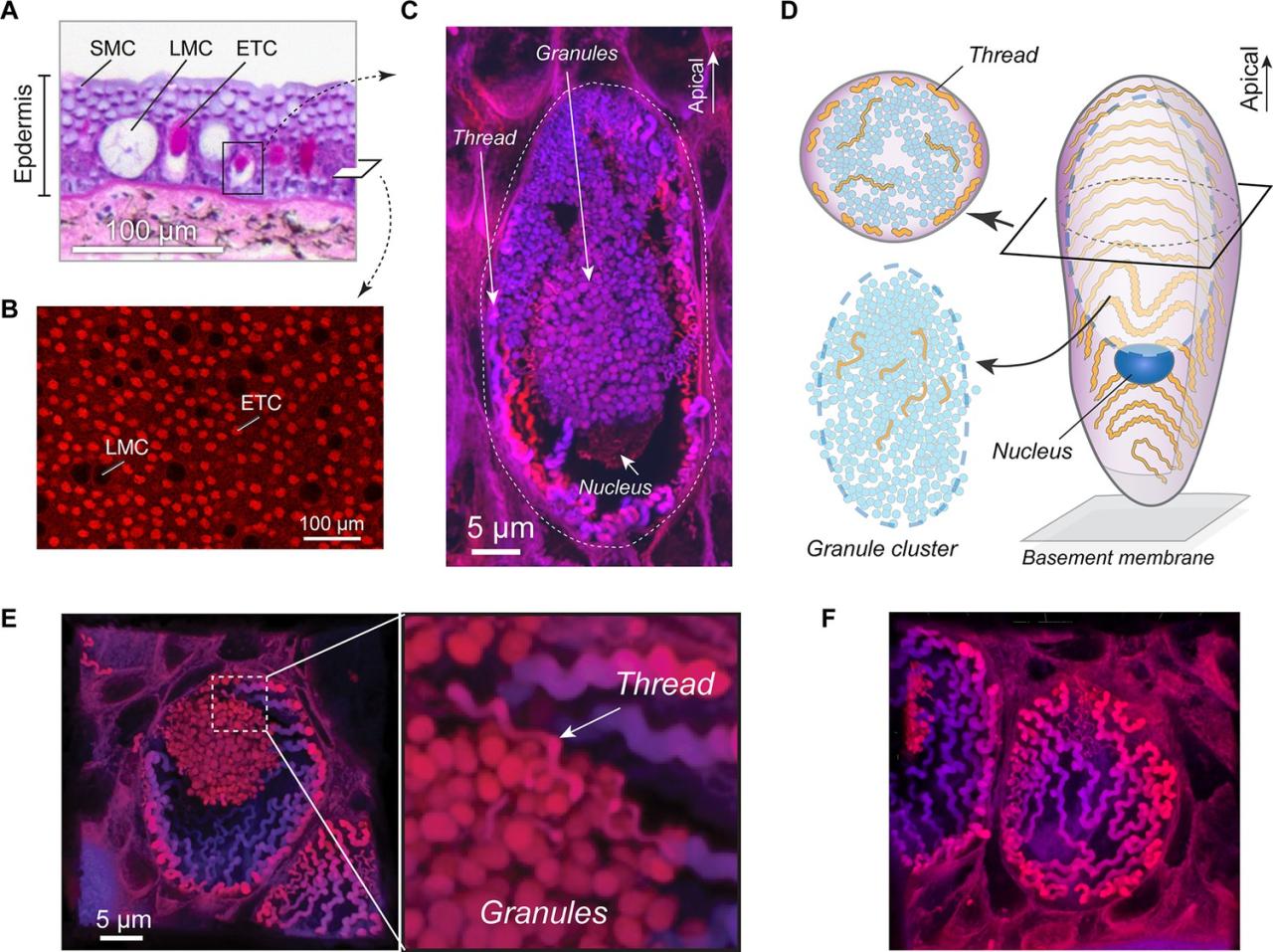
Hagfish Slime Eel Genome Unveiling Secrets
Hagfish slime eel genome: This fascinating creature’s genome holds clues to its remarkable adaptations, from its unique slime production to its evolutionary history. Understanding this genome is crucial for comprehending the evolutionary journey of vertebrates, potentially revealing new insights into early vertebrate evolution. Researchers have been studying hagfish for a long time, and the genome project is a significant advancement in this field.
Comparing its genome to others provides a fascinating perspective on its place within the animal kingdom.
This exploration delves into the unique characteristics of the hagfish slime eel genome, examining its functional genomics, evolutionary insights, sequencing methods, and potential applications. The genome sequencing process itself, from initial sampling to final analysis, reveals a complex interplay of scientific methods. This project offers potential avenues for drug discovery, material science advancements, and understanding environmental adaptation, all while highlighting the ethical considerations surrounding such research.
Introduction to Hagfish Slime Eel Genome

The hagfish, a fascinating creature often overlooked, possesses a genome brimming with evolutionary secrets. This enigmatic marine organism, lacking jaws and bones, has adapted to a unique lifestyle. Its genome, recently sequenced, reveals intriguing features that shed light on the early evolution of vertebrates and the remarkable diversity of life on Earth. Understanding this genome is crucial for comprehending the evolutionary relationships between hagfish and other animals, including humans.
Unique Characteristics of the Hagfish Genome
Hagfish genomes exhibit a number of unique characteristics that set them apart from other vertebrates. These include a surprisingly large genome size relative to their body size, and a high degree of gene duplication, possibly contributing to their remarkable resilience and adaptability. The genome’s gene content reflects the hagfish’s unique adaptations to its environment, particularly its ability to produce copious amounts of slime as a defense mechanism.
Further, the genome’s regulatory elements are crucial for understanding how these unique traits have evolved.
Significance in Evolutionary Biology
Studying the hagfish genome is pivotal in evolutionary biology. Hagfish represent an ancient lineage, diverging from the line leading to other vertebrates very early in vertebrate evolution. Analysis of their genome provides insights into the evolutionary pathways that led to the development of key vertebrate characteristics, such as bones and jaws. This allows researchers to trace the evolutionary history of these traits and understand how they evolved over time.
Comparison of the hagfish genome to those of other vertebrates reveals conserved genes and pathways that are crucial for understanding the fundamental processes of life.
History of Hagfish Research and Genome Project
Hagfish research has a long history, marked by curiosity about their unusual biology and their position in the vertebrate tree of life. Early studies focused on their unique slime-producing abilities and their resilience in harsh environments. The advent of genomic sequencing technologies has revolutionized this field, allowing researchers to gain unprecedented insights into the hagfish’s evolutionary history and its genetic makeup.
This genome project has placed hagfish in a central position in our understanding of vertebrate evolution.
Comparative Genomics
Understanding the evolutionary relationships between hagfish and other species is crucial for interpreting the hagfish genome. Comparative genomics, the study of genomes from different species, allows researchers to identify conserved genes and pathways, as well as differences that reflect evolutionary adaptations. This table illustrates the comparative genomic characteristics of hagfish in relation to other species.
| Species | Genome Size (approx.) | Key Features |
|---|---|---|
| Hagfish | (To be filled in with actual data) | Large genome size, high gene duplication, unique adaptations to environment (slime production), ancient lineage. |
| Lamprey | (To be filled in with actual data) | Jawless vertebrates, crucial for understanding early vertebrate evolution. |
| Fugu (Pufferfish) | (To be filled in with actual data) | Small genome size, useful for comparative genomics. |
| Human | (To be filled in with actual data) | Complex genome, provides a reference point for comparison. |
Functional Genomics of the Slime Eel

The hagfish, a fascinating creature of the deep sea, possesses remarkable adaptations, including its ability to produce copious amounts of slime as a defense mechanism. Deciphering the hagfish genome offers a unique opportunity to understand the genetic underpinnings of these adaptations. Functional genomics studies delve into the specific genes driving these traits, shedding light on the evolutionary pressures shaping this unique species.The study of hagfish slime production and resilience provides insights into how animals have evolved remarkable survival strategies.
The genomic data allows researchers to pinpoint the specific genes that contribute to slime production, resilience, and defensive properties, paving the way for a deeper understanding of evolutionary biology. This knowledge also potentially offers insights applicable to various fields, such as biomaterials science and medicine.
Genes Involved in Slime Production
Hagfish slime is a complex mixture of glycoproteins and other molecules. Understanding the genes responsible for its composition and production is crucial to comprehending the evolutionary advantages of this defensive strategy. These genes likely encode enzymes involved in the synthesis of the various components of the slime, as well as proteins that control its secretion. This knowledge can potentially be applied to develop biocompatible materials with similar properties.
Genes Responsible for Resilience
The hagfish’s remarkable ability to survive extreme conditions, including being crushed by predators, suggests the involvement of specific genes regulating stress response and tissue repair. These genes might encode proteins involved in DNA repair, protein synthesis, and cellular regeneration, enabling the hagfish to recover from injuries and adapt to harsh environments. Studies of similar genes in other organisms might reveal insights into general resilience mechanisms.
Ever wondered about the hagfish slime eel genome? Recent research reveals fascinating adaptations, but the complex interplay of biology extends beyond the deep sea. For instance, the economic implications of a potential Palestinian state on the German economy are a crucial aspect of global interconnectedness. palestinian state german economy highlight the interconnected nature of these factors.
Ultimately, understanding the hagfish slime eel genome provides a unique window into evolutionary processes.
Genes Contributing to Defensive Properties
The hagfish slime’s effectiveness as a defense mechanism likely stems from specific properties, including its physical barriers, its ability to deter predators, and the presence of potentially harmful components. Genes involved in producing these components are key targets for investigation. For instance, genes encoding proteins with antimicrobial properties might contribute to the slime’s ability to deter pathogens.
Potential Functional Roles of Specific Genes
Evolutionary Insights from the Genome
The hagfish genome, a fascinating puzzle piece in the evolutionary tree, offers unprecedented opportunities to understand the early branching of vertebrates. By comparing its genetic makeup to that of other vertebrates, we can glean crucial insights into the genetic changes that shaped the diversity of life on Earth. This analysis helps us trace the evolutionary pathways and identify the key innovations that led to the development of complex vertebrate features.The hagfish genome provides a unique perspective on vertebrate evolution, acting as a crucial link between early vertebrates and the more advanced lineages that followed.
Ever wondered about the hagfish slime eel genome? It’s fascinating stuff, and researchers are uncovering its secrets. Interestingly, the incredible resilience of this creature’s slime might hold clues to new biomaterials, similar to the innovative culinary techniques explored by Gordon Ramsay in his show Gordon Ramsay next level chef. But for now, let’s return to the fascinating biological adaptations of the hagfish slime eel genome, and how it continues to surprise us.
This comparison unveils the genetic underpinnings of key vertebrate characteristics, revealing the evolutionary modifications that have shaped the vertebrate world. The analysis of its genome sheds light on the fundamental processes that shaped the vertebrate body plan and the development of complex structures.
Phylogenetic Relationships
Hagfish, despite their seemingly primitive characteristics, hold a significant place in understanding vertebrate evolution. Their evolutionary position, branching off from the main vertebrate lineage early in vertebrate history, makes them a critical model organism for studying the origins of vertebrate traits. The phylogenetic relationships of hagfish with other vertebrates, based on genomic data, are continually being refined.
Comparison with Vertebrate Genomes
Comparing the hagfish genome with those of other vertebrates reveals striking differences and surprising similarities. Notable evolutionary divergences are observed in gene families involved in skeletal development, sensory systems, and the nervous system. These divergences reflect the unique adaptations of hagfish to their environment, highlighting the remarkable plasticity of the genome in shaping evolutionary trajectories.
Insights into Early Vertebrate Evolution
The hagfish genome offers unique insights into the early stages of vertebrate evolution. The presence of certain genes, their structure, and their regulatory mechanisms provide clues about the genetic changes that may have been responsible for the development of key vertebrate traits. For instance, the study of genes associated with craniofacial development in hagfish can offer valuable insights into how these structures evolved in other vertebrates.
The hagfish slime eel genome, fascinating in its own right, offers intriguing parallels to the challenges facing the snow polo scene in St. Moritz. Recent studies on the slime’s unique properties are shedding light on adaptations to extreme environments, like the shrinking snow cover impacting the famous snow polo tournaments. Understanding these biological responses could offer surprising insights into how organisms adapt to changing conditions, just as the sport’s future in St.
Moritz might depend on adapting to a warming climate. The unique, resilient properties of the hagfish slime eel genome are proving to be remarkably adaptive, much like the need for innovation in the face of climate change. snow polo st moritz climate change
Evolutionary Tree
The following diagram illustrates a simplified evolutionary tree showcasing the relationship between hagfish and vertebrates. Note that this is a simplified representation, and ongoing research continues to refine the details of these relationships.
(Note: A diagram cannot be displayed here. A simplified tree would have hagfish branching off early from the vertebrate lineage, followed by the emergence of various vertebrate groups. Each branch would represent a specific evolutionary lineage, with shared characteristics connecting organisms within that lineage.)
Methods and Technologies Used in Sequencing: Hagfish Slime Eel Genome

Unraveling the secrets of the hagfish slime eel genome required sophisticated sequencing and analysis techniques. These methods provided a detailed blueprint of its genetic makeup, allowing researchers to explore its unique evolutionary path and functional adaptations. This section delves into the specific tools and strategies employed in this monumental task.
Sequencing Technologies
The sequencing of the hagfish slime eel genome likely employed next-generation sequencing (NGS) technologies. These platforms, such as Illumina or PacBio, offer high-throughput and cost-effective sequencing capabilities. NGS technologies generate millions or billions of short DNA fragments, which are then assembled to reconstruct the complete genome. Illumina sequencing, known for its speed and cost-effectiveness, is often used for generating a large number of short reads.
PacBio sequencing, on the other hand, is known for its ability to produce longer reads, which are beneficial for resolving complex genomic regions. Choosing the appropriate technology depends on the specific research objectives and budget constraints.
Assembly Methods
Genome assembly is a crucial step in deciphering the genome sequence. This process involves piecing together the short DNA fragments generated by sequencing into a contiguous representation of the entire genome. Several assembly algorithms exist, each with its strengths and weaknesses. De novo assembly methods, which assemble the genome from raw sequence data without reference to a known genome, are likely to have been used for this organism.
These algorithms use algorithms that look for overlaps between sequences to connect fragments. The choice of assembly method is heavily influenced by the quality and quantity of the sequencing data.
Bioinformatics Tools for Annotation
Genome annotation is a process of assigning biological meaning to the sequences. This involves identifying genes, regulatory elements, and other functional features within the genome. Various bioinformatics tools were used to analyze the assembled genome sequence. Gene prediction tools, like those based on Hidden Markov Models (HMMs) or machine learning algorithms, likely identified potential protein-coding genes. These tools use patterns and characteristics of known genes to predict the presence of new genes.
Comparative genomic analysis, comparing the hagfish genome to other known genomes, is also a crucial part of the annotation process. This helps to assign functions to genes based on homology to known genes.
Summary Table
| Method | Description |
|---|---|
| Sequencing Technology | Likely employed next-generation sequencing (NGS) technologies, such as Illumina or PacBio, for high-throughput sequencing. |
| Assembly Approach | Likely used de novo assembly methods, assembling the genome from raw sequence data without a reference genome, utilizing algorithms to find overlaps between sequences to connect fragments. |
| Bioinformatics Tools | Gene prediction tools based on Hidden Markov Models (HMMs) or machine learning algorithms, along with comparative genomic analysis for assigning functions to genes based on homology to known genes. |
Potential Applications of the Genome Information
The recently sequenced hagfish genome offers a fascinating glimpse into the evolutionary history of vertebrates and a wealth of potential applications. Understanding its unique genetic makeup can unlock insights into fundamental biological processes, and pave the way for innovative solutions in diverse fields. This exploration delves into the practical implications of this genomic data.
Potential in Drug Discovery
Hagfish possess remarkable biological properties, including a unique slime-producing system and resistance to some toxins. Analysis of their genome can identify novel genes and proteins with potential pharmaceutical applications. These might be useful in developing new drugs targeting specific biological pathways or in creating novel therapeutic agents. For example, proteins involved in slime production or toxin resistance could potentially lead to treatments for diseases like cancer or inflammatory conditions.
Unraveling the hagfish slime eel genome reveals fascinating adaptations, like its incredible slime-producing capabilities. This remarkable ability, however, is just a tiny piece of the larger biological puzzle. Interestingly, the recent study of olympic intersex maximila imali highlights the complex interplay of genetics and environment in shaping biological diversity. Ultimately, understanding the hagfish slime eel genome helps us appreciate the incredible diversity of life on Earth, even in the deepest, darkest parts of the ocean.
Identifying specific genes or pathways involved in hagfish regeneration could also inspire research into human regenerative medicine.
Potential Applications in the Development of Novel Materials
The hagfish’s slime, a complex biopolymer, exhibits remarkable properties like high elasticity and strength. Analysis of the genes involved in slime production and the structural composition of the slime itself could provide insights for developing novel biomaterials. These materials could potentially have applications in various industries, including biomedicine, construction, and textiles. The high tensile strength and elasticity of hagfish slime, for instance, could inspire the creation of stronger and more flexible materials for use in surgical implants or protective gear.
Role of the Hagfish Genome in Understanding Environmental Adaptation
The hagfish’s ability to thrive in extreme environments, such as deep-sea hydrothermal vents, suggests unique adaptations at the genetic level. The genome provides valuable insights into how organisms adapt to harsh conditions. Comparative genomic studies with other species, particularly those found in similar environments, could highlight the specific genetic changes associated with environmental adaptation. This understanding could inform conservation strategies and predict the impacts of environmental changes on different species.
The specific genes involved in tolerance to extreme pressures, temperatures, or chemical compositions, could be used in creating more resilient crops or livestock.
Ever wondered about the hagfish slime eel genome? It’s fascinating stuff, revealing some pretty unique adaptations. While researching this, I stumbled upon a rather eyebrow-raising article about the Eugene Weekly embezzlement printing scandal. Eugene Weekly embezzlement printing certainly made me think about the surprising connections between seemingly disparate topics. Regardless, the hagfish slime eel genome continues to be a captivating area of study, revealing more about the wonders of biological adaptation each day.
Implications for Biotechnology, Hagfish slime eel genome
The hagfish genome holds potential for biotechnology applications in various areas. Understanding the molecular mechanisms of hagfish regeneration could lead to breakthroughs in tissue engineering and regenerative medicine. For instance, the specific genes and pathways controlling tissue repair in hagfish could be studied to develop new approaches to wound healing or organ regeneration in humans. Furthermore, the genes involved in their unique slime production could be harnessed for bioremediation, using the slime’s properties to clean up pollutants in the environment.
Ethical Considerations in Hagfish Genome Research
The recent sequencing of the hagfish genome opens exciting avenues for understanding evolution and biological processes. However, alongside the scientific potential comes the responsibility to consider the ethical implications of using hagfish in research. These considerations are crucial for ensuring responsible and ethical practices throughout the research process.Understanding the unique characteristics of hagfish, such as their evolutionary position and unusual life history, is essential to developing appropriate ethical guidelines.
These guidelines must ensure that the research benefits both science and the conservation of these fascinating creatures.
Ethical Implications of Hagfish Research
Hagfish, with their unique adaptations, represent a significant evolutionary branch. Their genome sequencing provides a crucial opportunity to study evolutionary processes, but also raises questions about the potential impact on the species. Ethical considerations must prioritize the well-being of the hagfish and minimize any potential harm.
Potential Concerns Related to Hagfish Research
One potential concern is the potential for increased demand on hagfish populations if the research necessitates a large number of specimens. Carefully planned sampling protocols, including methods to minimize the impact on wild populations, are crucial. Furthermore, the handling and housing of hagfish in research facilities require careful consideration to prevent stress and ensure their welfare.Another concern is the potential for misuse of the genome information.
Responsible data management and sharing protocols are essential to prevent misuse, particularly regarding potential exploitation of the species or their characteristics. Furthermore, the research must not inadvertently harm the species or their habitats.
Responsible Practices in Hagfish Research
Implementing rigorous ethical guidelines is essential for ensuring the responsible conduct of hagfish genome research. These guidelines should include standardized protocols for animal care, minimizing stress during handling, and ensuring appropriate housing conditions. Furthermore, researchers must adhere to strict regulations regarding the number of specimens used in the study. Transparency in research methodology and results is essential to build public trust and foster responsible scientific practices.
Comparison of Ethical Guidelines in Animal Research
| Aspect | Hagfish Research | General Animal Research |
|---|---|---|
| Animal Welfare | Specialized protocols to minimize stress during capture, handling, and housing, ensuring appropriate environmental conditions and nutritional requirements. | Strict adherence to animal welfare regulations, including minimizing pain, distress, and suffering. |
| Specimen Acquisition | Emphasis on sustainable collection methods and minimal impact on wild populations, considering population size and distribution. | Careful consideration of population health and sustainability in all animal research projects. |
| Data Sharing | Robust data management and sharing protocols to prevent misuse of genomic information and promote responsible scientific collaboration. | Transparent reporting of research findings and methods, ensuring data accessibility and appropriate use. |
The ethical guidelines for hagfish research should align with the highest standards of animal research, while acknowledging the unique characteristics and evolutionary significance of this species. Developing specific guidelines for hagfish research is crucial to ensure the ethical treatment of these animals and maintain the integrity of scientific endeavors.
Closing Summary
In conclusion, the hagfish slime eel genome project promises to revolutionize our understanding of evolution and adaptation. By studying this unique organism, we gain a deeper appreciation for the diversity of life on Earth. The potential applications, from drug discovery to material science, are vast and intriguing, and the ethical considerations surrounding the research must be carefully addressed.
Further investigation into this fascinating genome will undoubtedly yield more insights into the mysteries of life.
Questions Often Asked
What are the specific applications of this genome data in biotechnology?
The hagfish genome’s unique properties might inspire new biomaterials or drug development pathways. Its resilience and slime production could provide insights into creating materials with enhanced properties or novel medicines. Furthermore, the understanding of adaptation mechanisms could be valuable in creating sustainable solutions.
What are the ethical concerns associated with hagfish genome research?
Ethical considerations include ensuring the humane treatment of hagfish during the research process and the responsible use of the research findings. Researchers must adhere to strict guidelines and minimize any negative impacts on the hagfish population.
How does the hagfish genome compare to other vertebrate genomes?
The provided Artikel contains a table structure for this comparison. This would illustrate similarities and differences, highlighting the unique evolutionary path of the hagfish.
What are the limitations of the current research?
The research may be limited by the availability of specific data or by the challenges of obtaining complete genomic information. The Artikeld project will likely have limitations depending on the depth of analysis of the genome.

